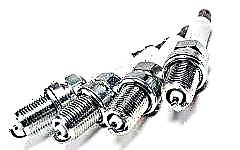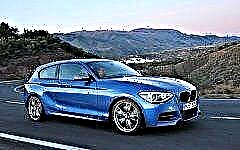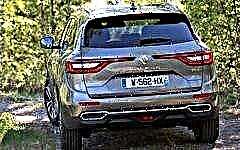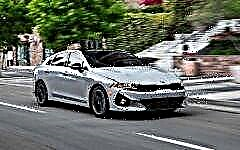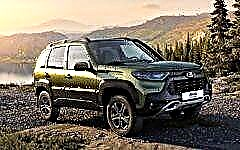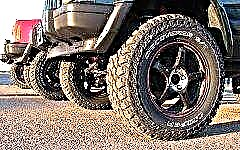

The content of the article:
- The best tires for summer use
- The best tires for winter without studs
- The best winter tires with studs
- The best tires for dirt and off-road
Tires play a key role in vehicle stability and safety. Moreover, the greater the weight of the vehicle, the higher the requirement for tires.
That is why you need to choose rubber for an SUV with special scrupulousness, and in order not to get lost in the whole variety of offers on the domestic market, we offer a selection of the best tires for SUVs, which we conditionally divided into 5 subspecies:
- summer tires;
- studless winter tires;
- studded winter tires;
- mud tires.
The best tires for summer use
Michelin Pilot Sport 4 SUV

These tires are deservedly popular among fans of fast driving on the highway and specialized tracks. Unlike competitors' products, the tire is asymmetrical for maximum responsiveness regardless of weather conditions. So, the outer protector is responsible for maximum control of the car in dry weather, while the outer protector is responsible for precipitation.
Tests have shown that Pilot Sport 4 SUV tires have 1 m less stopping distance than their predecessors. In addition, the tires have excellent resistance to lateral rolling and axle drift during sharp maneuvers.
Toyo Proxis STIII

These tires have been developed for use on sport utility vehicles, which are characterized by excellent dynamics and almost never roll off on bad roads.
The central part of the tires received cone-shaped and arrow-shaped blocks, which have a positive effect on the directional stability of the vehicle and provide excellent grip even on wet road surfaces.
In addition, the tires boast 3D Multiwave cut sipes and specially angled side blocks to reduce the risk of uneven wear. All this made it possible to reduce the level of fuel consumption, increase the maximum speed limit and reduce the noise while driving.
Yokohama parada spec-x

Expensive and high-quality rubber that provides a comfortable ride both off-road and on the highway (but remember that the tire is suitable for driving at a speed of no more than 150 km / h). Its main advantage is a low level of wear, which allows the tires to be used for 3-4 seasons.
The tires have a unique tread pattern - one concentric groove in the center and deep wavy sipes, which ensure efficient removal of slurry and dirt from under the contact zone of the tire with the road surface.
But there is also a minus, which manifests itself in increased fuel consumption in case of installation of an incorrect configuration in height and width.
The best tires for winter without studs
Nokian Tires Hakkapeliitta R3 SUV

These tires are characterized by lightness, economy and minimal aquaplaning. However, their main advantage is the pronounced reinforcement of the sidewalls, which provides the necessary level of grip when it is necessary to get out of the icy rut.
Reinforced edges also minimize the chance of accidental puncture or cut, which directly affects rubber life. Among the disadvantages are the high price and mediocre handling on ice.
Yokohama Geolandar I / T-S G073

This rubber model is considered one of the most durable - if you believe the reviews of the owners, Yokohama Geolandar can "walk" up to 10 seasons.
The tires have a high-quality tread pattern, which provides excellent grip and allows you to confidently row and pound loose snow.
In addition, the tire has a soft and quiet "Velcro", which allows you to confidently ride on ice. However, there is a small disadvantage, which manifests itself in the long stopping distance. The tires also refuse to leave the rolled snow or icy track - however, 90% of the velcro products on the market are guilty of this.
Bridgestone Blizzak DM-V2

It is the ideal tire for driving on rough and uneven dirt roads found in small towns. In such conditions, the tires perfectly get rid of snow and ice porridge.
Another advantage is resistance to low temperatures. Even at -20 ° C rubber does not freeze and retains its characteristics. However, as soon as you roll back into the heat, the tires begin to annoy with excessive aquaplaning and mediocre water drainage, which requires the driver to have increased steering response and more dosed use of the accelerator pedal.
Additional praise deserves excellent wheel balancing, low noise level and short braking distances.
The best winter tires with studs
Michelin X-Ice North 4

The tires sport an arrow-shaped tread pattern, which has been complemented by a fair amount of studs that have undergone significant changes compared to the previous generation of the model. During the modernization, the manufacturer achieved a significant increase in the contact area with ice, which had a positive effect on braking distance and handling while driving on ice.
Somehow miraculously, the specialists managed not only to maintain the level of acoustic comfort at an acceptable level, but to increase the frost resistance to -65 ° C.
The only stumbling block was the price, which increased along with the growth of the consumer characteristics of rubber.
Nokian Tires Hakkapeliitta 9 SUV

This tire model was recognized as the best in the tests initiated by the Norwegian Automobile Federation. The advantages of Tires Hakkapeliitta 9 include excellent lateral stability, high cross-country ability, effective braking and good handling when moving on ice.
Among the disadvantages of the model are predictably noisy and high cost, but otherwise this is one of the best winter studded tires on the market.
Goodyear Ultra Grip Ice Arctic SUV

These relatively inexpensive tires provide high-quality grip both on the track and when driving off-road, which is achieved through the use of a high tread and a unique arrangement of studs - from the periphery to the center part.
Users of Ultra Grip Ice Arctic tires complain about the strange behavior of the car during tire break-in, but after its completion, their operation does not raise any questions, delighting the owner with excellent grip on icy road sections and excellent cross-country ability in deep snow.
The best tires for dirt and off-road
BFGoodrich All-Terrain T / A KO2

These tires are recognized as the leader in rough terrain, the main disadvantage of which is their price. The tires have powerful reinforced sidewalls that reliably protect the rubber from punctures and allow you to confidently keep in track and increase grip while driving on it.
An added bonus is the versatility of the tires, which do an excellent job of driving on the track, which you definitely don't expect from mud tires. An insignificant disadvantage can also be considered an increase in fuel consumption by 0.5 liters, but given the performance of rubber, you can close your eyes to this.
Henkuk Tire Dynapro MT RT03

These tires are renowned for their versatility, in order to achieve which the manufacturer had to sacrifice off-road capability.
When driving on asphalt, the tire practically does not emit extraneous noise, and the deep tread and high checkers prevent aquaplaning, so with this rubber you can safely ride at high speed on wet asphalt.
According to users, TIRE DYNAPRO MT RT03 tires on average can move about 70-80 thousand km, which is a very decent result for rubber in this price category.
COMFORSER CF3000

A fairly cheap model of mud rubber, which is very popular among domestic car owners. The key advantage of COMFORSER CF3000 is the soft rubber composition, which does not lose its elasticity even at -30 ° C. In addition, the tires exhibit moderate ride noise, making them well suited for urban use.
Among the disadvantages of this tire model are low wear resistance, as well as mediocre behavior of the car when driving on a straight line and exiting a high track. However, these disadvantages can be minimized if an experienced driver is behind the wheel.



